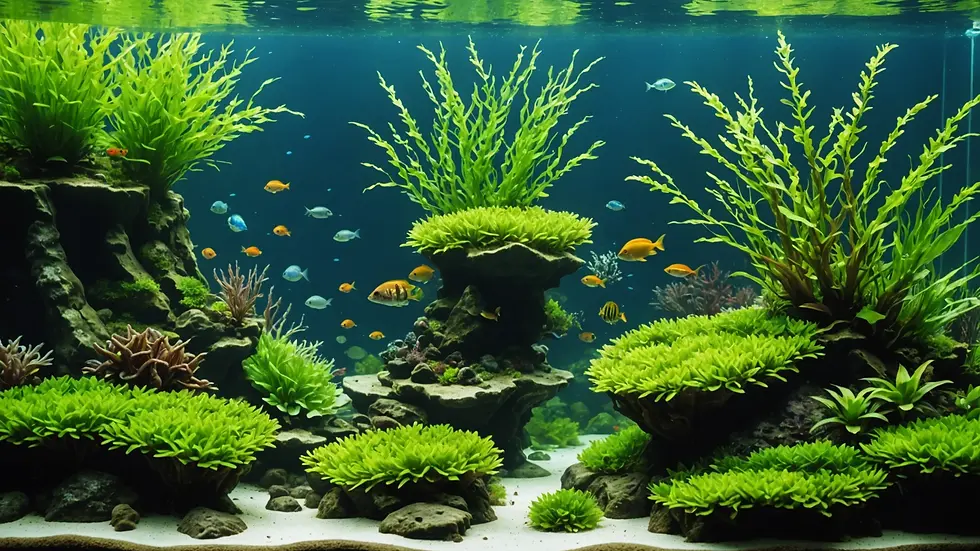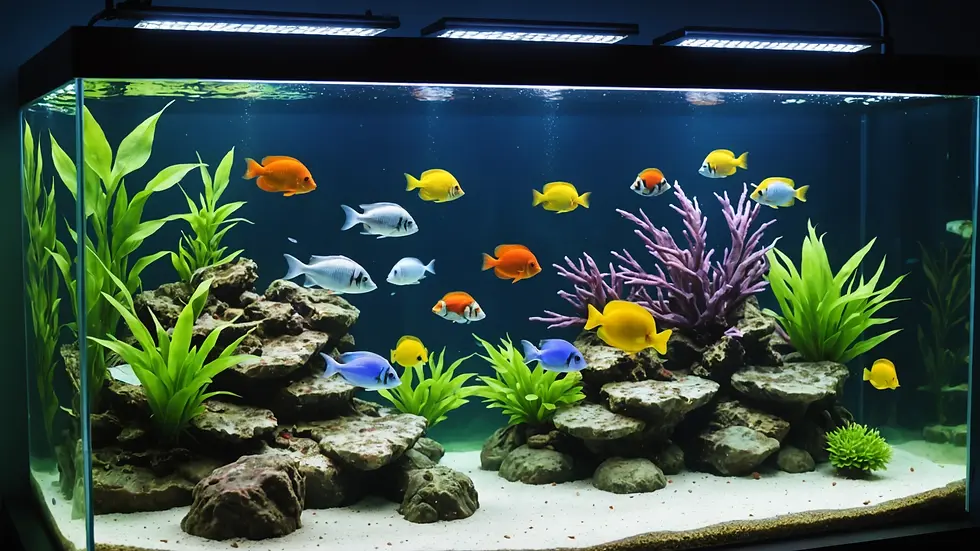How to Troubleshoot and Solve Common Issues with Aquarium Plants
- Jyotiraj Borah
- Feb 7
- 4 min read
Maintaining a thriving aquarium is an exciting adventure, but it comes with its share of challenges, especially regarding aquatic plants. These plants can beautify your tank, but they often face a range of problems that affect their growth and vitality. In this guide, we will discuss common issues with aquarium plants and provide practical solutions to help you create a lush, vibrant underwater garden.
The Value of Aquarium Plants
Aquarium plants are essential for the health of your aquatic ecosystem. They not only enhance the tank's visual appeal but also play a critical role in oxygen production, providing a habitat for fish and other aquatic creatures. Moreover, plants absorb excess nutrients, helping keep the water clean and safe for your fish.
However, these plants can face challenges that impede their development. Recognizing these troubles early will allow you to take action before they become more significant issues.
Recognizing Common Plant Problems and Their Symptoms
Nutrient Deficiencies
Nutrient deficiencies are one of the most frequent issues aquarium plants encounter. Essential nutrients, such as nitrogen, phosphorus, and potassium, are vital for growth. If your plants are wilting or have yellowing leaves, they may lack these nutrients.
Solution
To address nutrient deficiencies, invest in high-quality aquatic plant fertilizers that contain both macro and micronutrients. For instance, using a fertilizer with a ratio of 10-10-10 ensures a balanced supply of nitrogen, phosphorus, and potassium. Regular water testing is crucial—aim for levels where nitrate is below 25 mg/L to maintain a healthy balance.
Algae Overgrowth
Algae can be a natural part of any tank environment, but uncontrolled growth can smother your plants and prevent photosynthesis. If you see green sludge on leaves or walls, it's a sign of an algae problem.
Solution
Limit your tank's light exposure to 6 to 8 hours daily to reduce algae growth. In addition, ensure your water is clean with regular maintenance, including a 20% water change every two weeks. Consider incorporating fast-growing plants like Elodea or Hornwort; they compete with algae for nutrients and light, keeping algae levels in check.

Poor Water Quality
Water quality is vital for aquatic plants. High levels of ammonia or nitrites can lead to plant stress. For example, plants may show signs of discoloration, wilting, or even die if water quality dips below safe levels.
Solution
Perform regular water tests to monitor parameters such as ammonia and nitrite levels—aim for ammonia below 0.5 mg/L and nitrite below 0.1 mg/L. Regular water changes, combined with a reliable filtration system, can help maintain healthy water conditions.
Light Issues
Aquatic plants require specific light spectrums to thrive. Insufficient light can make them leggy and weak, while excessive light can promote rapid algae growth.
Solution
Research the light requirements of your specific plants. For instance, Java Fern requires low to moderate light, while Ludwigia prefers high light. Investing in adjustable LED lights can provide a flexible lighting solution, allowing you to modify the intensity according to your plants' needs.

Pests and Insects
Pests, such as snails and specific insects, can damage your aquarium plants, hindering their growth.
Solution
Before adding new plants, inspect them thoroughly and quarantine as needed. You can manually remove pests or apply aquarium-safe treatments. Additionally, consider introducing fish species that feed on pests, like Pygmy Corydoras, which can help keep the population in check.
Root Issues
Healthy roots are essential for plant survival. If you notice dark, mushy roots, your plant may be suffering from root rot, often caused by poor substrate or overwatering.
Solution
Ensure you use a substrate suited for your plants, such as nutrient-rich substrate for heavy root feeders like Amazon Sword. If root rot is present, gently remove the affected plant, trimming any damaged roots, and replant it in fresh substrate.
Temperature Fluctuations
Stable temperatures are crucial for aquatic plant health. Significant temperature changes can stress plants, leading to browning or leaf drop.
Solution
Choose a reliable heater and thermometer to maintain a consistent temperature suitable for your aquatic plants—typically between 72°F and 78°F. Regularly check the temperature to avoid sudden changes.
Compatibility Issues with Fish
Some fish can be detrimental to aquatic plants, nibbling on or uprooting them, which makes survival difficult.
Solution
When selecting fish, focus on species that coexist well with plants. Tetras and rasboras, for example, are generally safe choices. Researching fish behavior before introduction can save you from future headaches.
Overcrowding
Creating an overgrown environment can lead to overcrowding. This limits water circulation and deprives individual plants of the resources they need.
Solution
Regular pruning is essential. Aim to thin out your plants every few months to ensure ample space for each one to flourish. Proper spacing allows for better water flow and nutrient access for all plants.
Strategies for Healthy Aquarium Plants
Consistent Maintenance
Routine maintenance is essential to prevent many common issues. Schedule water changes, pruning, and health checks for your plants.
Pairing Compatible Plants
When setting up your tank, choose plants that complement each other. For example, pairing Cryptocorynes with Anubias creates a balanced ecosystem since they thrive under similar light and nutrient conditions.
Aquascaping Techniques
Utilizing aquascaping can enhance plant health. Incorporate rocks and driftwood to create structure and provide rooting areas for your plants.
Using Carbon Dioxide (CO2)
Adding CO2 to your aquarium can significantly boost plant growth. For example, those with high light setups should consider installing a CO2 injection system; studies show it can improve growth rates by up to 50%.
Final Thoughts on Cultivating Healthy Aquarium Plants
Managing common aquarium plant problems can seem overwhelming, but with understanding and practical solutions, you can create a thriving underwater landscape. Regular monitoring of your plants, maintaining optimal water conditions, and making adjustments as necessary will go a long way. Healthy aquatic plants not only beautify your aquarium but also contribute to a better ecosystem for all its inhabitants. Enjoy your aquascaping journey!




Comments